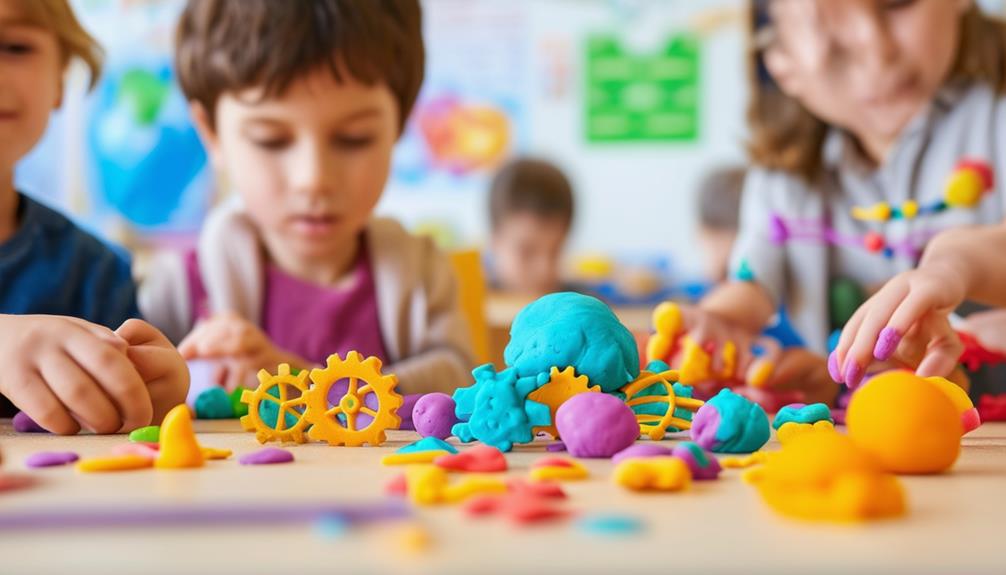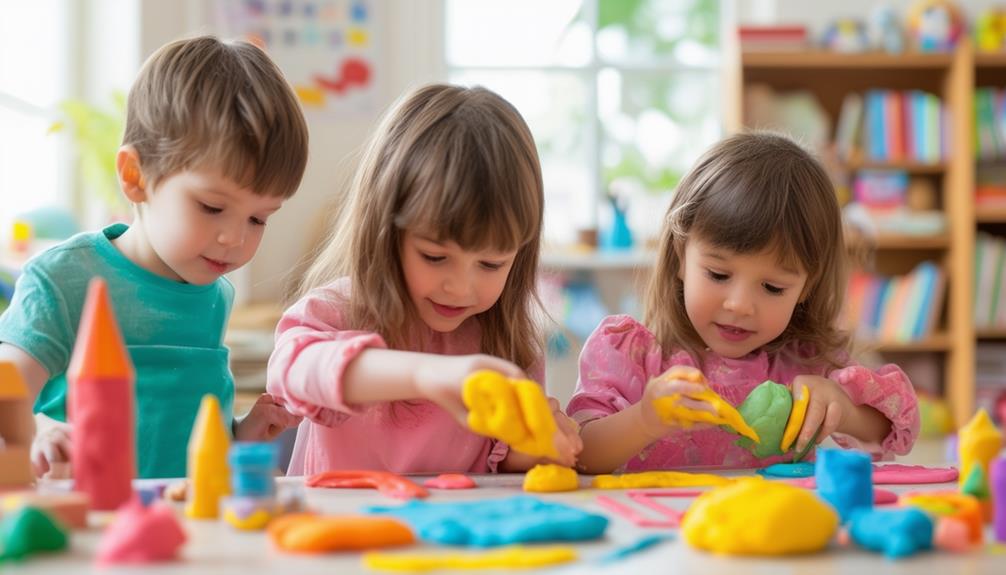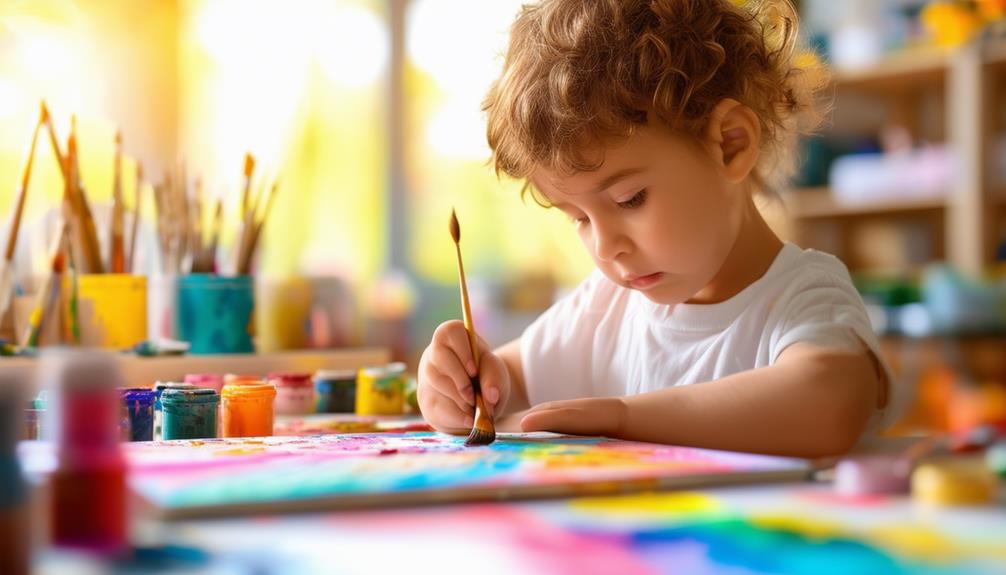The Role of Playdough in Early Childhood Education

Have you ever noticed how children are captivated by playdough? This simple, colorful substance does more than entertain; it nurtures fine motor skills, hand-eye coordination, and creativity. Additionally, playdough contributes significantly to social and emotional development. When children share and collaborate during play, they learn essential communication skills. Playdough also serves as a powerful tool for fostering language, literacy, and even STEM learning. Curious how this versatile material achieves so much?
Developmental Benefits
Playdough offers a multitude of developmental benefits that foster the growth of essential skills in children. Manipulating playdough helps develop fine motor skills by strengthening hand muscles and improving finger control. Actions such as rolling, squishing, and shaping the dough enhance these skills, which are crucial for tasks like writing and buttoning clothes.
In addition to fine motor development, playdough also enhances hand-eye coordination. Using tools like rolling pins, cutters, and molds, children learn to synchronize their hand movements with their visual input, thereby refining their precision and control.
Language development is another significant benefit. When children describe their creations, tell stories, or engage in imaginative play with playdough, they expand their vocabulary and improve conversational skills. This helps them articulate their thoughts and ideas more effectively.
Creativity and imagination flourish with playdough. This versatile medium allows children to express their ideas freely, whether they are creating animals or imaginary worlds. Through experimenting with different shapes and structures, they learn to think creatively and solve problems.
Social and Emotional Growth
Engaging in playdough activities fosters essential social skills such as sharing, cooperation, and effective communication among young children. By working together with playdough, kids learn to negotiate and practice empathy. This social interaction is crucial in early childhood, as it helps children express their emotions and build self-esteem.
Playdough also aids in emotional regulation. Its tactile nature provides a sensory exploration experience, offering children a safe space to explore and manage their feelings. When kids mold and shape playdough, they can channel their emotions constructively, reducing stress and frustration.
Here's a quick look at the benefits:
| Benefit | How it Helps | Keywords |
|---|---|---|
| Sharing | Encourages taking turns | social, working together |
| Cooperation | Promotes teamwork | develop, working together |
| Effective Communication | Improves verbal skills | social, communication |
| Emotional Regulation | Manages stress and frustration | emotional regulation |
| Sensory Exploration | Engages tactile senses | sensory exploration |
When children engage with playdough, they don't just create objects; they also build significant social and emotional skills. These interactions lay a solid foundation for their future relationships and emotional well-being, making playdough an invaluable tool in early childhood education.
Enhancing Creativity

Beyond fostering social and emotional growth, working with playdough ignites creativity in young minds. When children use playdough, they embark on imaginative journeys, exploring different shapes, textures, and colors. This hands-on activity allows them to create unique designs and art projects, providing a rich medium for self-expression.
As children mold and shape playdough, they enjoy hours of fun while developing essential fine motor skills. These activities strengthen the muscles in their hands and fingers, crucial for writing and other tasks. The focus required to manipulate playdough also enhances concentration and attention spans, benefiting other areas of learning.
Using playdough in early childhood education settings not only boosts creativity but also enhances social interactions. Children often share materials, discuss their creations, and collaborate on joint art projects, fostering a sense of community and teamwork. This cooperative play encourages children to express their ideas and listen to others, thereby improving their social skills.
In essence, playdough is more than just a toy; it's a versatile educational tool that nurtures creativity, develops muscles, and improves concentration, all while providing endless opportunities for children to express themselves and have fun.
Language and Literacy Skills
Children frequently enhance their language and literacy skills through playdough activities. Describing their creations helps them learn new words and expand their vocabulary. As they manipulate the dough into various shapes, they use descriptive language to discuss colors, sizes, and textures, promoting active engagement and communication.
Playdough also offers an excellent opportunity for children to practice letter formation and recognition. By shaping alphabet letters, they reinforce their understanding of different letters and sounds. Handling materials and tools to shape the dough develops hand-eye coordination, essential for pre-writing skills.
Additionally, children develop storytelling abilities by creating narratives around their playdough figures and scenes. This imaginative play boosts creativity and enriches their ability to structure sentences and build coherent stories. Engaging in these activities fosters a love for language and communication, setting a strong foundation for future literacy skills. Playdough makes learning enjoyable and effective for young children.
STEM Learning

Playing with playdough does more than just enhance language and literacy skills; it also provides young children with hands-on science experiences. When children mold and shape playdough, they engage in scientific thinking and exploration, learning about materials, textures, and cause-and-effect relationships essential to STEM learning. This tactile activity helps early learners grasp complex concepts in a fun and engaging manner.
Playdough activities also foster crucial problem-solving skills and mathematical thinking. For example, measuring, dividing, and counting playdough pieces involve basic math operations, laying the groundwork for more advanced STEM concepts.
Imagine the joy on their faces as they:
- Discover that mixing colors creates new hues.
- Experiment with various shapes and sizes.
- Observe how adding water changes the dough's texture.
- Build structures and understand stability.
These moments of discovery are invaluable, fostering curiosity and a love for learning. They encourage children to ask questions and think critically. Playdough isn't just a toy; it's a powerful tool that prepares young minds for future STEM challenges.




